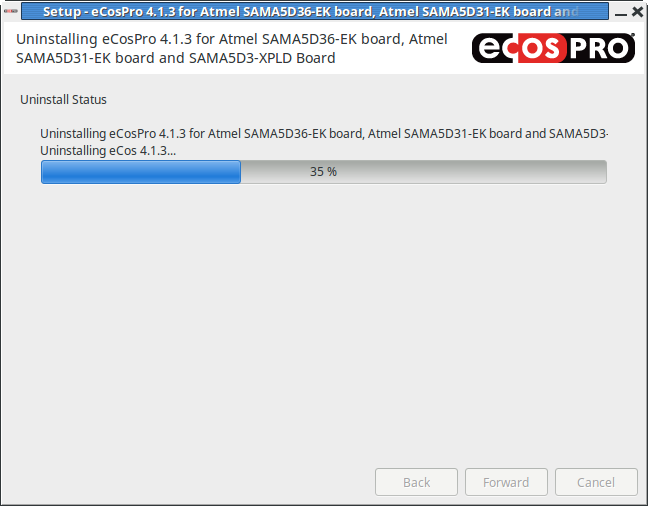Chapter 10. Uninstalling
Table of Contents
In order to uninstall eCosPro and it's components, each component must be uninstalled individually. This is done by running the uninstaller located in the base of each installation directory, or by using the native application management tool (Windows only). Uninstallation will remove the menu items, documentation and files for the respective component.
The uninstaller only removes unmodified files and directories that were unpacked during the installation process. Any files or directories that have been modified following installation, or added into the install location at any time, will remain in place following the uninstallation. The installer achieves this by tracking all the files it installed and unpacked using a hidden file located in the top-level install directory. If this file is deleted, renamed or corrupted in any way, the uninstallation may fail.
![[Warning]](pix/warning.png) | Warning |
|---|---|
If you attempt to uninstall any eCosPro component which is still in use by another component the functionality of the dependent eCosPro component may be broken as a result. |
![[Note]](pix/note.png) | Notes |
|---|---|
|
10.1. Uninstalling on Windows
All eCosPro components may be uninstalled through the standard Programs and Features mechanism illustrated in Figure 10.1, “Programs and Features on Windows 7” or the Setting mechanism, illustrated in Figure 10.2, “Programs and Features on Windows 10”.
![[Note]](pix/note.png) | Note |
|---|---|
If components are uninstalled along with an eCosPro
|
Figure 10.1. Programs and Features on Windows 7

Figure 10.2. Programs and Features on Windows 10

In addition, at the top-level of each directory for each installed component is an executable which, when executed, will uninstall that particular component.
Figure 10.3. Example list of uninstallers for Windows-based OSes
C:\eCosPro\ecos-4.1.3\ecospro-4.1.3-sama5d3x-windows-uninstall.exe C:\eCosPro\eclipse-1.5.3\ecospro-eclipse-1.5.3-windows-uninstall.exe C:\eCosPro\ecoshosttools-4.0.2\ecoshosttools-4.0.2-windows-uninstall.exe C:\eCosPro\gnutools-arm-eabi-4.7.3j\ecospro-gnutools-arm-eabi-4.7.3j-windows-uninstall.exe
10.2. Uninstalling on Linux
Due to the numerous methods employed by different Linux distributions for installing and uninstalling packages, the main method for uninstalling eCosPro is through the menu item. This executes an uninstaller created during installation. Each eCosPro component installed will also have an associated uninstaller located at the top level of each component directory, illustrated in Figure 10.4, “Linux List of Uninstallers”. Each uninstaller will uninstall individual components or releases, with primary installers giving you the option of also uninstalling the associated components (see Figure 10.5, “Uninstall eCosPro” for an example).
Figure 10.4. Linux List of Uninstallers
test@ubuntu:/tmp$cd /opt/ecosprotest@ubuntu:/opt/ecospro$ls */*-uninstalleclipse-1.5.3/ecospro-eclipse-1.5.3-linux-x64-uninstall ecos-4.1.3/ecospro-4.1.3-sama5d3x-linux-x64-uninstall ecoshosttools-4.0.2/ecoshosttools-4.0.2-linux-x64-uninstall gnutools-arm-eabi-4.7.3j/ecospro-gnutools-arm-eabi-4.7.3j-linux-x64-uninstall test@ubuntu:/opt/ecospro$
Figure 10.5. Uninstall eCosPro

![[Note]](pix/note.png) | Note |
|---|---|
The uninstallers will attempt to run in a graphical mode if possible.
If you wish to uninstall using console mode, pass the parameters
“ |
| 2025-10-02 | eCosPro Non-Commercial Public License |


